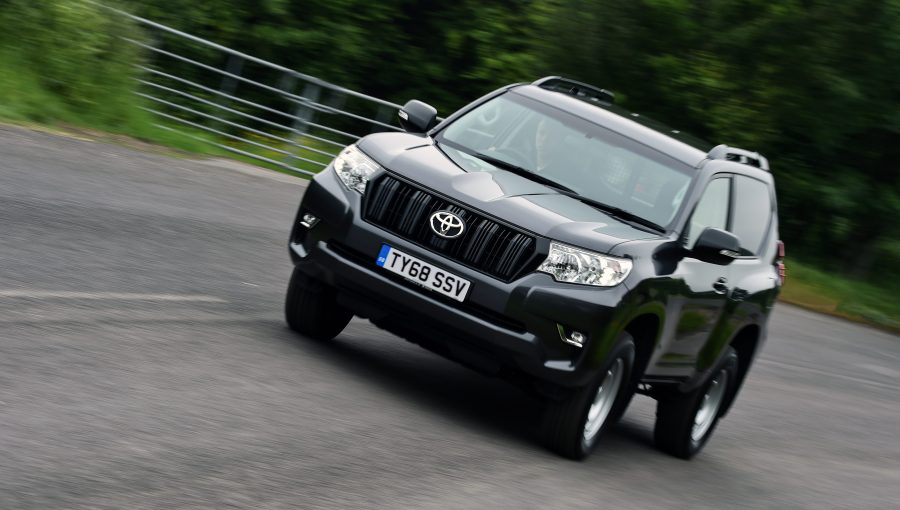Although Toyota’s passenger car range is predominantly focused around petrol-electric hybrid powertrains, the Land Cruiser, Hilux and Proace models are fitted with diesel engines. A diesel particulate filter (DPF) is a feature of these models, and you may have heard about the need for regular DPF regeneration. What does this component do and how do you take care of it?
What does a diesel particulate filter (DPF) do?
The DPF is fitted within the exhaust system and is designed to catch soot particles and nitrous oxide (NOx) from the combustion process that would otherwise be released into the atmosphere. The DPF is highly effective and traps around 80% of these harmful particulates.

Why do modern diesel engines need a DPF?
European legislation places strict exhaust emissions targets on all vehicle manufacturers. From September 2009, the Euro 5 legislative standard came into effect, part of which required all diesel cars registered from that point on to be equipped with a diesel particulate filter, or DPF.
These filters are used throughout the industry in all diesel-powered passenger vehicles, and their efficiency is vital now that stringent Euro 6d emissions standards are in force.
Do I need to replace a DPF during normal servicing?
Diesel particulate filters do have a capacity limit and can become full. But unlike traditional air, oil or pollen filters that need to be exchanged manually at regular intervals, the DPF has a much longer service life and is designed to regenerate to restore its performance.
The car’s electronic control unit (ECU) is programmed to do this automatically, neutralising the soot by burning it off at high temperature within the exhaust system while the vehicle is running. All modern cars with diesel engines follow this procedure.

How does DPF regeneration occur?
The regeneration occurs automatically, usually without the driver being aware that it is taking place. In the majority of cases, the process is carried out when the engine and exhaust system has reached normal operating temperature and the vehicle is travelling at over 40mph.
However, if your driving is limited to urban areas, the low speeds and frequent stops mean the conditions for normal regeneration do not exist. In these instances, the ECU monitors the accumulation of soot and instructs an alternative regeneration programme to begin well before the filter becomes saturated.
This programme injects small quantities of fuel into the engine after combustion, which increases the temperature within the exhaust system and creates an environment where it is possible to safely burn off the soot.
This method is very successful within the small percentage of vehicles where normal regeneration is not possible. However, due to the nature of city traffic, the regeneration process can be interrupted when the vehicle completes its short journey and is turned off. If this occurs, the ECU is programmed to recommence the process when the engine is restarted and back up to temperature again.

How can I help prevent DPF blockages in my Toyota?
Follow these four simple actions:
1. Regularly drive your Toyota on highways at speeds of between 40-55mph for around 20-30 minutes.
2. Avoid spending unnecessary amounts of time with the engine idling.
3, Try to limit the frequency of short journeys where the engine is running for less than ten minutes.
4. Do not ignore dashboard alerts related to the DPF.
Will I be warned if all DPF regeneration processes have been unsuccessful?
Very occasionally, use of the vehicle might be such that it will have been impossible for the ECU to complete the administration of any regeneration procedure. At this point, the DPF will have become overloaded and stopped functioning, so your Toyota will illuminate a warning light in the dashboard. It will then be necessary for the soot to be neutralised and the filter regenerated manually at a main dealer.
It is extremely unwise to ignore this visual warning as the DPF can become irreparably damaged. What’s more, it is illegal to remove the filter entirely.
Learn more: What is the exhaust gas recirculation valve and what does it do?





Hi, Can you identify if my Toyota Avensis d4d has a dpf.
I’m looking to change the SCV on the injection pump having identified it as faulty.
After a search of Denso e-catalogue it’s showing two SCV’s for my vehicle
04226-0L030 / 04226-26020 DCRS301370 without DPF
04226-0L040 / 04226-26030 DCRS301380 with DPF
Reg no. NL08 OWA
Hi Martin,
Thanks for getting in touch.
Your Avensis does not have a DPF.
We hope this helps.
Thanks.
Hi Toyota can you tell me if a land cruiser reg LT56UWS has a dpf filter thank you Mark
Hi Mark,
Thanks for getting in touch.
Your vehicle does not have a DPF.
Thanks.
Hi , I have a verso 7 seater almost a year now . I’m constantly having trouble with the dpf full light keep coming on dashboard. After Toyota garage where I purchased car checking it on computer saying nothing was wrong , then said some faulty valve was replaced, light back on and oil maintenance light on . Oil is like tar after a full service end February and back in garage in June. I’ve it booked in again for another service this week . I was told it was my short journeys but I drive 20 minutes daily to work morning and evening without slowing or stopping . At this stage I’m sick of it now and think my 2012 verso was far more reliable than this 171 verso . Would love some advise . What other car could you recommend for family of 6
Hi Caroline,
Thanks for getting in touch.
DPFs become blocked due to soot accumulating over time.
For the soot to be burnt off, the exhaust system needs to become very hot, which is why your Centre appear to have raised a point about carrying out lots of short journeys. Generally, it is advisable to carry out a journey at motorway speeds and for an extended period every so often to help the soot and carbon particles from accumulating. Leaving the transmission in a lower gear so that the engine RPM is increased can also help this.
As EU emission targets have become stricter over time, diesel vehicles have required the introduction of DPFs and can appear more sensitive should appropriate driving conditions not be met. Regular servicing and using the correct engine oil is therefore even more important.
You may want to pursue a Hybrid vehicle in our range such as the Prius+, which has 7 seats. For more information, please use the following link:
https://www.toyota.co.uk/hybrid/hybrid-range.
Hope this helps.
Will putting off cleaner in the fuel help the off clogging up
Hi Steven,
Thanks for getting in touch.
DPFs generally block due to soot, which can be burnt off at high exhaust temperatures.
Therefore a longer drive, getting the exhaust up to temperature is more advisable.
Fuel cleaner may assist in cleaning any of the fuel components from things such as carbon build up.
Hope this helps.
My avensis d4d , RK62UZM is putting out clouds of smoke that I think is caused by the dpf constantly regenerating , (the engine doesn’t use any oil or coolant between services)usually leaves loads of smoke behind when moving away from traffic lights etc , it also only returns about 32mpg which might suggest that the 5th injector is constantly open , any suggestions as to what may be at fault. No error codes when scanned, it’s a very poor display to see a Toyota taxi leaving clouds of smoke behind .
Any help is appreciated
Hi John,
Thanks for getting in touch and we are sorry to hear that you are experiencing these issues.
There could be numerous causes for excessive smoke being emitted.
The cause will need to be investigated fully and therefore we recommend for you to visit your local Toyota Centre so that they can assess the root cause. The 5th injector could be the cause and occasionally they can become blocked, however again, the root cause needs to be identified.
Hope this helps.
Hello John,
I have the same problem and after hours of maintenance still no solution.
The 5th injector is working from the moment the car reaches working temperature. I had to pull the plug of the 5th injector to get temporarily rid of the problem, but of course this is no permanent solution.
Did you find a solution for the problem?
Find this all very interesting. My wife purchased a Yaris Icon 1.4d in 2014 brand new. Very economical and decent to drive.
She drives motorway most days and the car has not been driven in a sluggish manner. Over 80000 very expensive miles on clock now.
Properly serviced etc etc
This week we are fitting our second brand new DPF!!!!
Total spend in excess of £1200 to date and we expect it will clog up again soon. Yes it regens. No we don’t switch off during regens.
Garage has done several forced regens…
I feel so sorry for my wife spending seemingly endless money on this little car.
Just trying to warn any ‘would be’ buyers
If only someone had warned us!
Is this vehicle really “fit for purpose?”
Hi Richard,
Thanks for getting in touch.
DPF’s can block depending on usage conditions.
This is usually linked to driving conditions that include a lot of stop/start or low speed city/town driving.
Under these conditions the DPF cannot regenerate efficiently.
However, the same issue may occur when driving the car on the Motorway but at slow speed and in high gear, e.g. 60mph in 6th gear.
Under these conditions the engine is operating at very low rpm which, again, is preventing efficient regeneration.
As a general rule that the engine needs to run at least at 2000 rpm so that regen can take place efficiently. Therefore, if the vehicle is being used on the Motorway at slow speeds in high gear, it might be worth shifting down a gear or two.
Thanks.
VW duped us all with their software that cheated the emissions tests, and they were deservedly penalised for this.
Toyota (along with many other car manufacturers) have duped the public with their DPFs in that they refuse to admit that they are not fit for purpose. When we bought these diesel cars, not one of them ever came with any guidance about how we had to drive them in order to accommodate for their flawed DPFs. Now that they’re failing long before they should, Toyota refuses to stand by them, and forces us to pay a fortune to have them replaced … only to have the new ones fail a few years later.
I used to think Toyota was the most reliable car on the market, but now they’re just as bad as all the rest.
Toyota has had numerous opportunities to do the right thing – even if that’s just a case of improving the designs of the new DPFs – but they won’t take that step until they recognise that they failed in the first place.
Thank you Toyota UK
I am amazed that Toyota know so much about our driving style!
The car has not been driven at low revs in high gear etc.
My wife does not do a lot of stop / start driving
She knows not to stop during a regen
She doesn’t do low speed town driving
By mentioning motorway driving I was simply making the point that she is not a low mileage/ snail type driver…
This morning I collect the car from a Toyota dealer and will be paying for a new DPF which brings our total DPF spend to apx £1350
Quite ridiculous
My next stage with this is the motoring press. Toyota leave me with no option but to tell my story to as many as possible.
I have also been told by your dealers that “all diesels have this problem!!!”
Unfortunately I can disprove this quite easily.
I appreciate the fact that you are keeping this blog open for my comments
Hi Richard,
Thanks for your response.
Within our reply we were trying to suggest some characteristics of driving styles that may explain the problems you are experiencing. In no way did we try to determine you or your wife’s driving style, we were simply offering some technical advice.
If these characteristics are not similar to the driving style you or your wife use, we would suggest contacting our Customer Relations team who will be more than happy to investigate into the issues you are experiencing.
You can contact them here: https://www.toyota.co.uk/contact-us/.
Thanks.
Hello. Does the 125 hp 2.0 D4D engine (Facelifted Avensis 2006) have a DPF? Reg hg56xlv. Thank you very much in advance.
Hi Dimi,
Thanks for getting in touch. Your vehicle is not fitted with a DPF.
Hope this helps.
Hi there,
Could you please confirm that my Avensis reg:YK57OVG isn’t fitted with DPF. Many thanks.
Kind regards.
Judit
Hi Judit,
Thanks for contacting us. We can confirm that the vehicle does not have a DPF fitted.
Hope this helps.
Hi could you please tell me if my Toyota avensis reg. FY59JWG has a DPF fitted? Many thanks.
Hi Andy,
Thanks for getting in touch. This vehicle has not got a DPF fitted.
Hope this helps.
Hi,could you tell me if my rav4 has a dpf and what sort of mileage I should be getting around town plz reg number yp60lwr (auto).ty
Hi Shawn
Thanks for getting in touch. This vehicle features a DPNR (Diesel Particulate-NOx Reductions) catalyst.
Real world economy figures can vary depending on driving style, road conditions, the amount of luggage or passenger weight. Your vehicle’s fuel economy was determined using the NEDC test, you can find out how this works via this link: https://mag.toyota.co.uk/how-official-fuel-economy-figures-are-calculated.
Hope this helps.
Hi, may I ask for information if my Land Cruiser j120 2006, d-4d 3.0, 120 kW, VIN: JTEBZ29J100076571 has DPF?
Hi Sebastian,
Thanks for getting in touch. We can confirm that this Land Cruiser does not have a DPF.
Hope this helps.
Hi, i have Toyota 1.4 automatic diesel 2007. I was driving and the dashboard was showing gear 4 but car didn’t take any race and eventually stopped on the road. After stopping the car was still showing 4th gear on the dadhboard. Upon pressing gas the car was not moving at all, i switched off the car and switched back again, no change and the dashboard was still showing 4th gear. It is happening everyday and car stuck in gear 5, 4 or 2 or any gear and i can’t change the gear with the stick. It itself started once i switched the car off. I don’t know what’s is happening, any advise please.
Hi Sayyad,
Thanks for getting in touch and we are sorry to hear that you are experiencing these issues. We would advise for you to contact your local Toyota Centre, as they will be able to assist you further through an inspection of the vehicle.